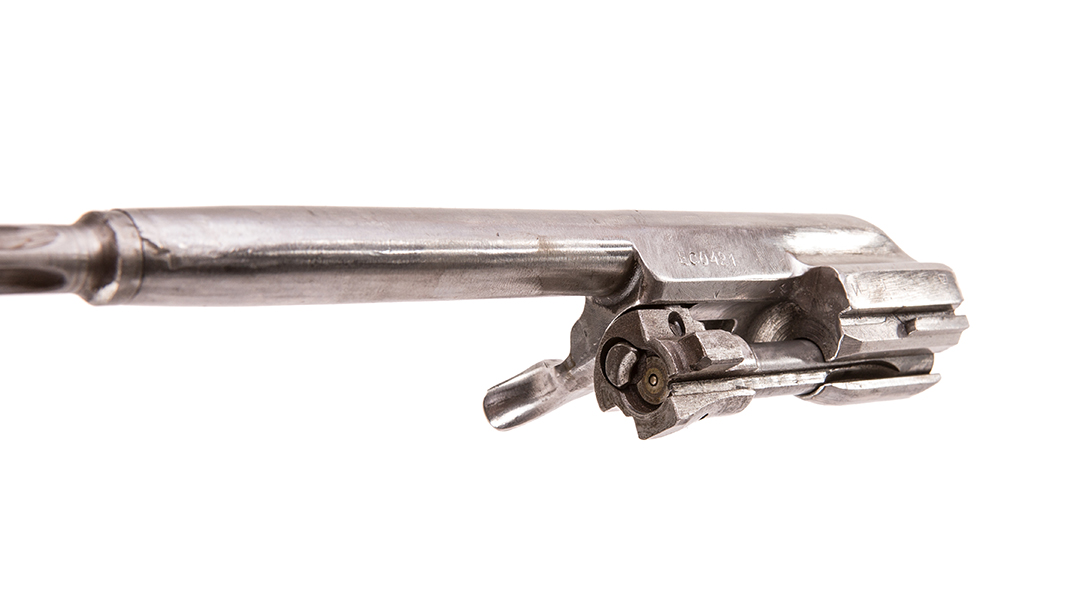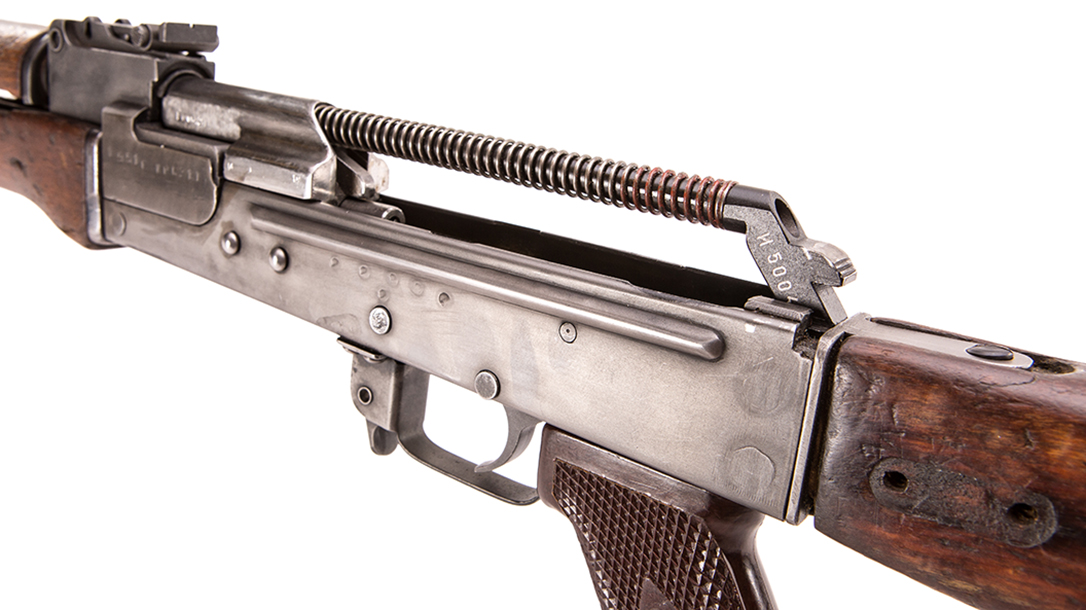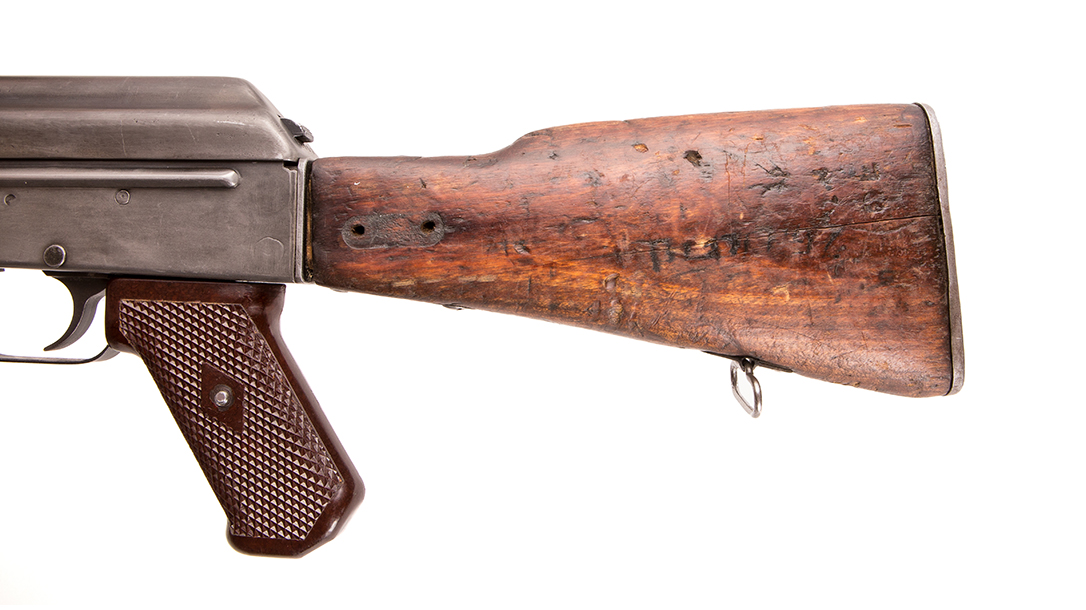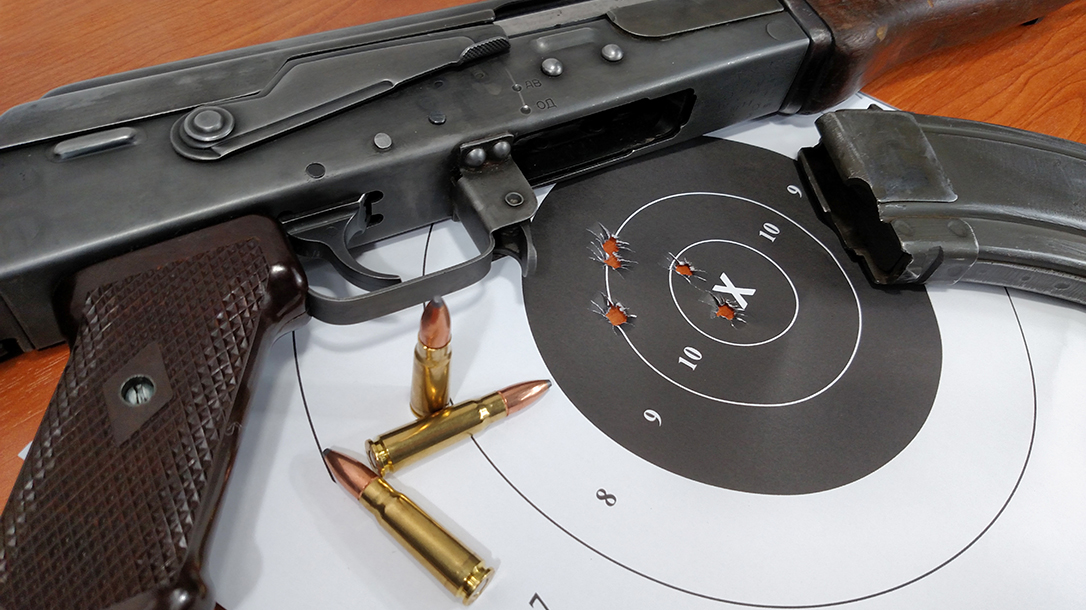It is undeniably one of the most easily recognizable and widely used weapons on Earth. The AK-47 is found in the hands of everyone from soldiers in major armies to rebels across the globe. Developed by Mikhail Kalashnikov in 1946 for use by the Soviet armed forces, it quickly gained approval and entered production. By 1949, the AK-47 was the official service rifle of the Soviets and was in use by the Soviet Union’s allies in the Warsaw Pact. The designation of AK-47 is derived from the Russian words “Avtomat Kalashnikova” to describe its automatic firing design as well as its designer, Comrade Kalashnikov.
By any method you choose to measure, the AK-47 is the most prolific fighting rifle in the history of man. Even in this ocean of guns, there are exceptional examples of very early models that have survived the storm. By nature, the AK-47 does not need a great deal of TLC to run. This characteristic also led to the demise of many guns because while they are hearty, they are not indestructible. An incalculable number of guns have fallen prey to neglect, rust and the ravages of time.
Advertisement — Continue Reading Below
To the hardcore collector, this is a painful thought. While there has been a long-standing cadre of AK-47 collectors, a renewed interest in this rifle over the past decade has seen those numbers rise. What is it that has brought a new growth to this well-established market? The answer to that is partially in the gun itself.
Blueprint For Success
The AK-47 is a gas-operated rifle designed to run in both semi- and full-auto. It grew from a desire to create a weapon in the line of the German Sturmgewehr (StG) 44 that the Russians saw so much of in the waning days of World War II. The desire to field a lightweight weapon capable of full-auto operation and chambered in the new 7.62x39mm was the driving force behind the gun. Early production AK-47s were broken down into two distinct batch types: the version from 1948 (Type I) and the version succeeding it from 1951 (Type II).
Some will argue that the AK-47 is not a purely original design; it is the child of several preexisting design concepts that Kalashnikov and his team used as motivation. The trigger mechanism, safety catch, rotating bolt and gas-driven action borrowed heavily from other firearms, yet it was Kalashnikov who brought it all together. The result of this focus and labor resulted in a lightweight rifle with only moderate recoil. It is easy to run and brought serious firepower to the hands of whoever was running it.
Advertisement — Continue Reading Below
Ubiquitous AK
While not noted for its exceptional accuracy, its durability and reliability became legend. The gun is designed to function regardless of environment or terrain. The internal tolerances are loose in comparison to other weapons, yet it runs in areas that easily foul up other guns. There is a reason you find AKs everywhere around the world. Additionally, the guns are simple to break down and clean when necessary.
Over time, the original design spawned multiple offshoots and versions. Add to that the blatant hijacking of the Kalashnikov design by other entities and the AK world quickly became a spectrum of versions and types. It is estimated that between 50 and 75 million AK-47s have been produced since the weapon’s inception. Add to that another 100 million units that were directly influenced or copied and you have yourself the most successful platform of all time.
A Truly Rare Find
As I mentioned earlier, the AK market has seen unprecedented growth over the last decade. An interest in the rifle both in a historical sense and as an economical shooter has played a big role. For years, ammo for recreational shooters to run their Eastern Bloc blasters was dirt cheap and range excursions were very enjoyable. Within this group of AK enthusiasts was a hardcore group of AK collectors. These men and women could look at a news photo taken in sub-Sharan Africa and tell you not only what model the AK was, but where it was from and generally when it was made. The ranks of the serious collectors have grown over the years, and each of them has a gun on their “wish list.” While some would settle for period-correct Bakelite furniture or slab-side magazines, others seek the most elusive items.
Advertisement — Continue Reading Below
One of which is undoubtedly the holy grail of all AK-47s: the painfully rare Type I. This is an incredibly rare example of an early model of the most influential combat rifle of the mid 20th to early 21st centuries. It is an understanding of the unique nature of this gun that almost caused me to choke when I walked into a friend’s shop to find this very rifle sitting on his desk.
Eastern Bloc Classic
Jason Swarr has long been an AK aficionado and collector of guns. So, I guess it should not surprise me when he let me know he had acquired a Type I when it came up at auction. Actually seeing this rare weapon was still an incredible moment. The Type I is the crown jewel for any serious collection. It is believed that there are four or less in the United States. This specific gun was made in 1951 and has two-piece Bakelite grips. It began its life as one of the rare PLO kits and quickly became the gun we see today.
With a patina only 67 years can bring, the gun is beautiful. The stock has its share of history and is a reminder that this was not a gun intended for a safe. This was a fighting rifle, and I am certain it was fired in that capacity on more than one occasion.
Advertisement — Continue Reading Below
Limited Range Time
While I was immediately determined to pen an article about this unique gun, I was also hopeful that I could get at least some limited range time with it. Jason happily agreed, and I was soon on my way with the Type I. Of course, a traditional rifle test would see me put hundreds of rounds through it, but that wasn’t the case here. The owner was kind enough to entrust me with this rifle, and I sure as heck wasn’t going to do any more shooting than absolutely necessary.
The general diet of the AK consists of steel-core ammo seated in steel cases. While easy to find, I was curious how if this classic shooter would like some more modern ammunition. So I chose some Federal 123-grain Power-Shok soft points (SPs).
Results
The rare Arizona rainstorm created an atmosphere that seemed almost home to the Type I. With a break in the rain, I carefully benched the gun and fired it to check its zero. I didn’t want to make any adjustments on the gun and was looking more for a hold point than anything else. After that, I fired an additional five rounds to get a group. And group it did. I was surprised to see that this antique of a weapon still punched out a 2-inch group at 100 yards—with iron sights as well.
Advertisement — Continue Reading Below
The trigger was the product of over six decades of self-polishing action as it broke more smoothly than any stock AK trigger I have ever run. Yes, the iron sights were less than optimal in a dim overcast light, but they still worked. The gun is not built around our modern OCD fascination with sub-minute-of-angle performance. These weapons were designed to shoot “minute of man,” and they do it well. The rifle fit me well, as it has millions of people over the years, and I could easily understand its appeal.
I have shot my fair share of AKs ranging from bargain-basement models to modern variants built with space-age materials. But there was something magical in shooting this Type I. It allowed me to become part of a long and special timeline. Some good and certainly some bad, yet all connected. It was a pleasure and an honor to spend some range time with the Type I. The generosity of the owner was quite humbling, and I will never forget it.
Advertisement — Continue Reading Below
Owning History
It is estimated that there are over 175 million AKs and variants floating around the planet. Many of those are average guns with average histories. The guns that really reach back in time, though, are rare and getting harder to find. Many of those guns were initially seen just as tools, and were treated as such. Many of the oldest guns are simply gone. Broken and discarded, rusted beyond recognition or stripped for parts. But against these odds, some of the oldest guns have survived. It is this knowledge that fascinates many collectors. Knowing that if the stars align, they may be able to someday get their hands on a gun that reaches back to the genesis of the most iconic weapon in human history.
AK-47 Type 1 Performance
| Load | Velocity | Accuracy |
|---|---|---|
| Federal 123 Power-Shok SP | 2,350 | 2.00 |
*Bullet weight measured in grains, velocity in fps per manufacturer specifications and accuracy in inches for one five-shot group at 100 yards.
This article was originally published in the 2018 issue of “AK-47 & Soviet Weapons.” To order a copy, visit outdoorgroupstore.com.
Advertisement — Continue Reading Below







































